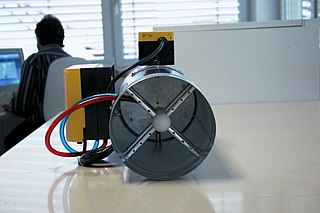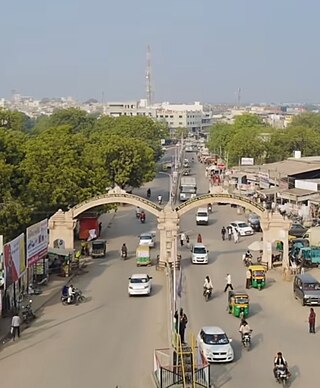Waw is the sixth letter of the Semitic abjads, including Arabic wāwو, Aramaic waw 𐡅, Hebrew vavו, Phoenician wāw 𐤅, and Syriac waw ܘ.

Patan is the administrative seat of Patan district in the Indian state of Gujarat and is an administered municipality. It was the capital of Gujarat's Chavda and Chaulukya dynasties in medieval times, and is also known as Anhilpur-Patan to distinguish it from Prabhas Patan. During the rule of Gujarat Sultanate, it was the capital from 1407 to 1411.
Vav is one of the 182 Legislative Assembly constituencies of Gujarat state in India. It is part of Banaskantha district. It is numbered as 7-Vav.

Stepwells are wells, cisterns or ponds with a long corridor of steps that descend to the water level. Stepwells played a significant role in defining subterranean architecture in western India from the 7th to the 19th century. Some stepwells are multi-storeyed and can be accessed by a Persian wheel which is pulled by a bull to bring water to the first or second floor. They are most common in western India and are also found in the other more arid regions of the Indian subcontinent, extending into Pakistan. The construction of stepwells is mainly utilitarian, though they may include embellishments of architectural significance, and be temple tanks.

Variable air volume (VAV) is a type of heating, ventilating, and/or air-conditioning (HVAC) system. Unlike constant air volume (CAV) systems, which supply a constant airflow at a variable temperature, VAV systems vary the airflow at a constant or varying temperature. The advantages of VAV systems over constant-volume systems include more precise temperature control, reduced compressor wear, lower energy consumption by system fans, less fan noise, and additional passive dehumidification.

Tharad isihe administrative center of the Vav-Tharad district. Here is 134 villages. Tharad is 45km near to international boarder with Pakistan and 40km to national boarder with Rajasthan. main industries are agriculture and private businesses. It is one of the first major towns in Gujarat on National Highway 68.

Sathamba is a town located in Aravali district of the Indian state of Gujarat and the seat of a former petty princely state. It has a population of approximately 15,000.
Holam or cholam is a Hebrew niqqud vowel sign represented by a dot above the upper left corner of the consonant letter. For example, here the holam appears after the letter mem⟨מ⟩: מֹ. In modern Hebrew, it indicates the mid back rounded vowel,, and is transliterated as an o.

Rani Ki Vav is a stepwell situated in the town of Patan in Gujarat, India. It is located on the banks of the Saraswati River. Its construction is attributed to Udayamati, the spouse of the 11th-century Chaulukya king Bhima I. Silted over, it was rediscovered in the 1940s and restored in the 1980s by the Archaeological Survey of India. It has been listed as one of the UNESCO World Heritage Sites in India since 2014. This stepwell is designed as an inverted temple highlighting the sanctity of water. It is divided into seven levels of stairs with sculptural panels. These panels have more than 500 principal sculptures and over 1000 minor ones combining religious, secular, and symbolic imagery.
The vav-consecutive or waw-consecutive is a grammatical construction in Biblical Hebrew. It involves prefixing a verb form with the letter waw in order to change its tense or aspect.
Kherali is a village in Surendranagar district in the Indian state of Gujarat. It comes on the way from Surendranagar to Limli, and this route leads to Muli. It has population close to 6,000-10,000. The village is grown around one abandoned palace. The village has got one big lake and many other wells including one stepwell. It has few temples including two Swaminarayan temple, Rama temple, krishna temple, shaktimaa temple and one well-built mosque. There are also government and one private school also. The village is mostly surrounded by farms. The population mostly depend on farming, and young generation go for jobs and business to Surendranagar and around cities. The main crops are wheat, cotton, ground-nuts, and sesames.
Sanval, is a village in Gujarat in western India. It is located in Vav Taluka, in Banaskantha district and has a population of 2,600 (2011).

Vav is a town and the headquarters of Vav Taluka in Vav - Tharad District in Gujarat state of India. Vav is the largest taluka of the district.

Vasa is a village in Sirohi District in Rajasthan state in India. It is 9 km from Swarupganj and 25 km from Abu Road and also known as Vasantpur or Vasantgarh. Vasa also has got a temple Laxminarayan Mandir whose foundation stone was laid by Mirabai.

Ghumli is a village located 45 km from Jamkhambhaliya, at foothills of Barda, in Devbhumi Dwarka district of Gujarat, India.
Vav Darreh is a village in Farim Rural District, Dodangeh District, Sari County, Mazandaran Province, Iran. At the 2006 census, its population was 112, in 35 families.
Vav is one of the 182 Legislative Assembly constituencies of Gujarat state in India. It is part of Banaskantha district. It is numbered as 7-Vav.
Halol is one of the 182 Legislative Assembly constituencies of Gujarat state in India. It is part of Panchmahal district.
Suigam is a village in Suigam Taluka of Maratha Riyasat in Gujarat, India, but it is now a Taluka of Vav-Tharad District in Gujarat.
Dhima is a village in Vav Taluka of Banaskantha district in Gujarat, India.








